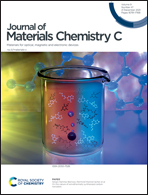Coumarin-embedded MOF UiO-66 as a selective and sensitive fluorescent sensor for the recognition and detection of Fe3+ ions†
Abstract
A fluorescent composite, HCAA@UiO-66, was prepared by encapsulating fluorescent 7-hydroxycoumarin-4-acetic acid (HCAA) molecules in the pores of a metal–organic framework (MOF, UiO-66). The encapsulation of HCAA in the pores of UiO-66 does not affect its crystalline and porous structure. HCAA@UiO-66 in ethanol displays a strong fluorescence emission and a highly selective fluorescence response towards Fe3+ ions. The fluorescence intensity of HCAA@UiO-66 at 451 nm shows a satisfactory linear relationship with the concentration of Fe3+ ions in a wide range of 0–400 μmol L−1 with a low detection limit (LOD) of 4.87 × 10−6 mol L−1. The fluorescence quenching is attributed to the interaction of Fe3+ ions with HCAA@UiO-66 and the absorption competition quenching (ACQ). HCAA@UiO-66 proved that the encapsulation of fluorescent dyes in the MOF is an efficient approach to fabricate fluorescent chemosensors for the determination of metal ions.



 Please wait while we load your content...
Please wait while we load your content...